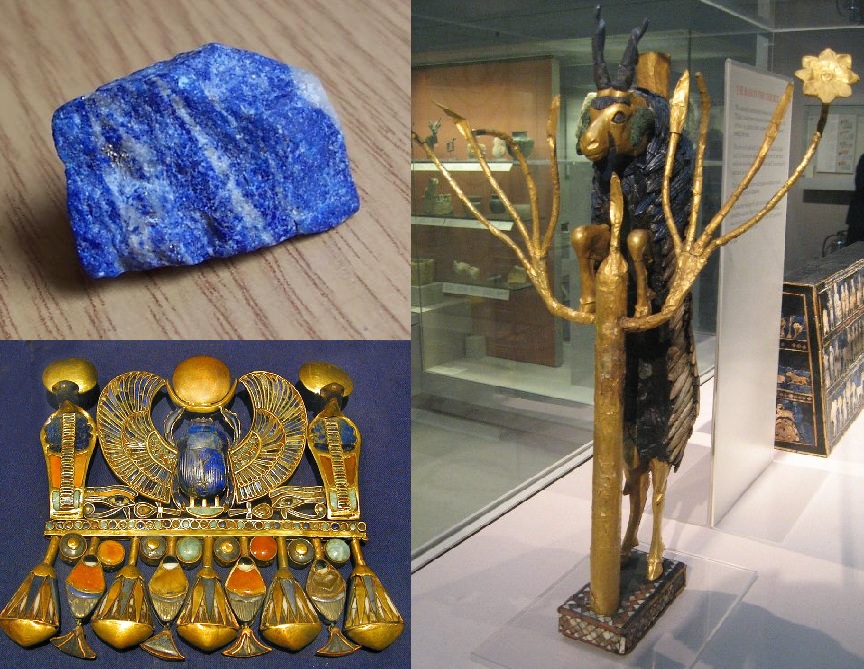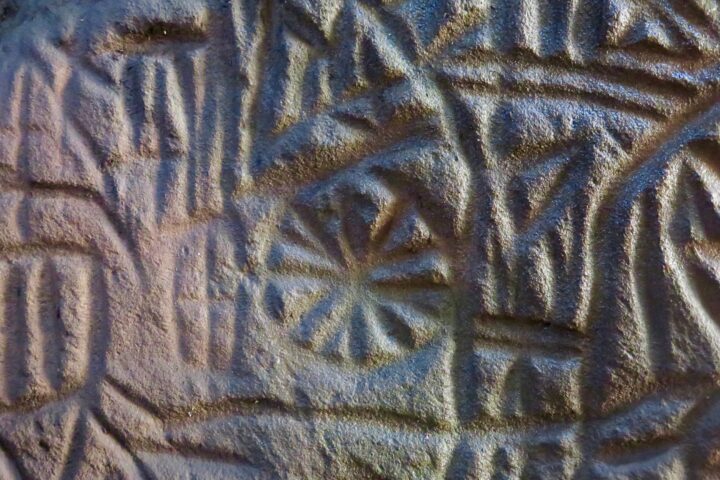Source: AncientLapisLazuli_lapis-lazuli-ancient-egypt-blue-pigment
Introduction
The allure of ancient Egypt has captivated humanity for centuries. Pyramids, hieroglyphs, and mummies are synonymous with this enigmatic civilization. However, beyond these iconic symbols lies a lesser-known aspect of Egyptian artistry: the extraordinary use of color. Among the vibrant palette employed by these master craftsmen, one pigment stands out for its rarity, value, and symbolic significance: lapis lazuli. This deep, intense blue hue, often associated with royalty and divinity, was a prized possession, reserved exclusively for the elite.
Lapis Lazuli: A Gemstone Turned Pigment
Lapis lazuli, a semi-precious stone renowned for its deep blue color with flecks of gold pyrite, has been cherished since antiquity. Its origins trace back to the remote mountains of Afghanistan, where it was mined under arduous conditions. The extraction process was perilous, and the stone itself was incredibly valuable.
To transform this precious gemstone into a pigment suitable for artistic purposes, lapis lazuli underwent a meticulous grinding process. The resulting powder was then mixed with a binding medium to create a vibrant blue paint. This process was time-consuming and costly, making the pigment a luxury item accessible only to the wealthiest patrons.
The Symbolism of Blue in Ancient Egypt
In the complex tapestry of Egyptian symbolism, the color blue held profound significance. It was associated with the sky, the Nile River, and the afterlife. The Egyptians believed that the sky was a celestial ocean, traversed by the sun god Ra in his solar boat. The Nile, the lifeblood of Egypt, was also seen as a divine waterway connecting the earthly realm to the underworld. Consequently, blue was a color of both life and eternity.
Lapis lazuli, with its intense blue hue, became the quintessential pigment for representing these celestial and aquatic concepts. It was used to adorn the walls of tombs, temples, and palaces, creating a sense of divine presence and cosmic order.
Lapis Lazuli in Royal and Religious Art
Given its rarity and symbolic importance, lapis lazuli was primarily reserved for the depiction of royalty and deities. The pharaohs, considered living gods, were often portrayed with lapis lazuli crowns, jewelry, and attire. This visual association elevated their status and reinforced their divine authority.
Temple walls were adorned with intricate frescoes featuring lapis lazuli to depict the heavens, the Nile, and the forms of gods and goddesses. The blue pigment was used to highlight the eyes of deities, symbolizing their wisdom and omniscience. It was also employed to create celestial backgrounds, evoking the vastness and mystery of the cosmos.
The Decline of Lapis Lazuli Use
The use of lapis lazuli in Egyptian art reached its zenith during the Old and Middle Kingdoms (c. 2686-1650 BCE). However, as the empire declined and trade routes became less secure, the supply of lapis lazuli dwindled. Consequently, artists began exploring alternative blue pigments, such as Egyptian blue, which was cheaper to produce.
While Egyptian blue eventually replaced lapis lazuli as the primary blue pigment, the latter continued to be used sparingly for special occasions or for highlighting specific elements within a composition. Even in the later periods of Egyptian art, the enduring allure of lapis lazuli ensured its place in the artist’s palette.
The Legacy of Lapis Lazuli
The legacy of lapis lazuli extends far beyond ancient Egypt. Its intense blue hue has captivated artists and artisans throughout history. The Renaissance masters, for example, prized lapis lazuli for its luminosity and depth. Today, it remains a sought-after gemstone and pigment, used in a variety of artistic and decorative applications.
The discovery of lapis lazuli in ancient Egyptian tombs has provided invaluable insights into the artistic techniques and cultural beliefs of this extraordinary civilization. By studying the meticulous application of this precious pigment, art historians and archaeologists have gained a deeper appreciation for the Egyptians’ mastery of color and their profound connection to the natural world.
The Artist’s Palette: A Challenge in Blue
While lapis lazuli was undoubtedly the king of blue pigments for the Egyptians, creating a truly vibrant and enduring blue was a challenge for artists across cultures and eras. The quest for the perfect blue has been a long and fascinating one. From the Egyptians to the Renaissance masters, artists experimented with various substances, often with mixed results.
One such experiment, though unintentional, led to a remarkable discovery. During the Roman period, glassmakers accidentally created a stunning blue glass while trying to imitate lapis lazuli. This discovery gave birth to cobalt blue, a pigment that would become a staple in artists’ palettes for centuries.
The Alchemy of Color: Creating Egyptian Blue
As mentioned earlier, the Egyptians developed their own synthetic blue pigment, known as Egyptian blue. This pigment was created by heating a mixture of sand, copper carbonate, lime, and an alkali. The resulting compound produced a vibrant blue that was more affordable and easier to produce than lapis lazuli.
Interestingly, Egyptian blue was not just a beautiful pigment; it also possessed unique properties. It was highly stable and resistant to fading, making it ideal for large-scale murals and frescoes. The secret to its creation was lost for centuries, only to be rediscovered in the 20th century.
Lapis Lazuli: A Modern-Day Allure
The allure of lapis lazuli has persisted through the ages. Today, it remains a prized gemstone, used in jewelry and decorative objects. Its deep blue color, often interspersed with flecks of gold pyrite, continues to captivate the imagination.
Beyond its aesthetic appeal, lapis lazuli is also believed to possess metaphysical properties. In many cultures, it is considered a stone of wisdom, truth, and inner peace. It is said to enhance intuition, creativity, and communication.
The Science Behind the Hue
The captivating blue color of lapis lazuli originates from the presence of lazurite, a complex mineral composed of sodium, calcium, aluminum, sulfur, oxygen, and silicon. The exact mechanism by which lazurite produces its distinctive blue hue is still a subject of scientific investigation.
Recent studies suggest that the color may be linked to the presence of sulfur-based compounds within the mineral structure. These compounds absorb light in the red and green parts of the spectrum, allowing only the blue light to be reflected.
Lapis Lazuli: A Timeless Treasure
From the ancient Egyptians to contemporary artists, lapis lazuli has held a special place in the human heart. Its rich history, combined with its stunning beauty and potential metaphysical properties, ensures its enduring appeal.
As we continue to explore the mysteries of the universe and the depths of our own consciousness, lapis lazuli serves as a reminder of the power of color to evoke emotion, inspire creativity, and connect us to something greater than ourselves.
Conclusion
Lapis lazuli, the royal blue of the gods, is a testament to the ingenuity and resourcefulness of the ancient Egyptians. This rare and precious pigment was transformed into a powerful visual language, used to convey the majesty of pharaohs, the divine nature of deities, and the cosmic order of the universe. While its use declined over time, the enduring allure of lapis lazuli continues to inspire artists and fascinate audiences centuries later.
Sources:
- https://en.wikipedia.org/wiki/Ultramarine#:~:text=Ultramarine%20is%20a%20deep%20blue,and%20as%20expensive%20as%20gold.
- https://en.wikipedia.org/wiki/Lapis_lazuli
- https://www.nytimes.com/2015/08/19/arts/international/lapis-lazuli-and-the-history-of-the-most-perfect-color.html
- https://www.dailyartmagazine.com/lapis-lazuli-pigment/
















